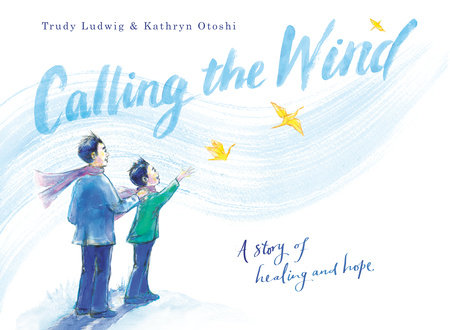A Note from the Author & Illustrator of Calling the Wind
Calling the Wind is a work of fiction inspired by kaze no denwa, the wind phone created by Itaru Sasaki of Ōtsuchi, Japan. In 2010, Sasaki set up a glass-paned phone booth that housed a disconnected rotary telephone in his back garden to privately express his grief over the death of his beloved cousin. Shortly after the 2011 earthquake and tsunami claimed thousands of lives, word spread about Sasaki’s phone booth, and many Japanese people made pilgrimages to find solace there.
Over the years, countless individuals from numerous countries have visited Sasaki’s phone booth on that windy coastal hill. Other phone installations have since shown up elsewhere in the world, including in the United States.
We first heard about Sasaki’s wind phone in 2017 on NPR’s This American Life at a pivotal time when we each were in the throes of our own personal losses. That podcast sparked the beginning of our collaboration on Calling the Wind.
While working on this project and consulting with experts, we’ve learned that grief isn’t a fixed or prescriptive go-from-one-stage-to-the-next kind of process. There are many emotions associated with it, and not everyone experiences grief in the same way. Each person’s experience with loss is as unique as the individual who experiences it.
Grief, like the ever-present wind captured in the illustrations, is fluid and has no set timeline. It fluctuates and varies in intensity and length for each individual. It is also important to note that children grieve differently from adults.
As David Kessler shares in his book Finding Meaning: The Sixth Stage of Grief (Scribner, 2019), there is still life and love after loss: “The world keeps spinning. The seasons change, the dead of winter gives way to the rebirth that occurs every spring. Every storm gives way to a clear new day. Despite our losses, we continue.”
Calling the Wind was created to help any young reader experiencing a loss (i.e., death, divorce, a change in way of life, etc.). We hope that children, along with the adults who work with them, will find our story a useful resource and soothing reminder of the healing power of human connection and hope.
-Trudy Ludwig and Kathryn Otoshi

Calling the Wind By Trudy Ludwig; illustrated by Kathryn Otoshi
Inspired by the Wind Telephone in Japan, this poignant story explores the stages of grief, the healing power of hope, and the unbreakable family bonds that connect us all. From the acclaimed author of The Invisible Boy and the award-winning illustrator of One.
In a small village in Japan, a family mourns the loss of their loved one. Each family member grieves in their own way, but it is not until they discover an old-fashioned telephone booth on a windswept hill that they begin to heal. Through the telephone, they are able to express feelings long bottled up--speaking directly to their loved one and also to each other. Slowly but surely, the pain subsides, and hope blossoms anew.
Inspired by Itaru Sasaki's Wind Telephone, which brought healing to the people of Japan in the wake of an earthquake and tsunami this story explores grief and loss, and how we move forward by finding meaningful ways to connect with the family and friends we've lost, as well as those who are still with us.
"Truly beautiful and poignant. This book is for anyone who's ever experienced loss or grief, which is to say: all of us." —Katherine Applegate, Newbery Award-winning author of The One and Only Ivan





